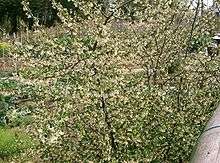Elaeagnus multiflora
| Elaeagnus multiflora | |
|---|---|
 | |
| Scientific classification | |
| Kingdom: | Plantae |
| (unranked): | Angiosperms |
| (unranked): | Eudicots |
| (unranked): | Rosids |
| Order: | Rosales |
| Family: | Elaeagnaceae |
| Genus: | Elaeagnus |
| Species: | E. multiflora |
| Binomial name | |
| Elaeagnus multiflora Thunb. | |
Elaeagnus multiflora, the cherry elaeagnus,[1] cherry silverberry,[2] goumi, gumi, or natsugumi, is a species of Elaeagnus native to China, Korea, and Japan.
Elaeagnus multiflora is a deciduous or semi-evergreen shrub or small tree growing to 2-8 m tall, with a trunk up to 30 cm diameter with dark brown bark. The shoots are densely covered in minute red-brown scales. The leaves are ovate to elliptic, 3-10 cm long and 2-5 cm broad, green above, and silvery to orange-brown below with dense small scales.
The flowers are solitary or in pairs in the leaf axils, fragrant, with a four-lobed pale yellowish-white corolla 1.5 cm long; flowering is in mid-spring.

The fruit is round to oval drupe 1 cm long, silvery-scaled orange, ripening red dotted with silver or brown, pendulous on a 2-3 cm peduncle. When ripe in mid- to late summer, the fruit is juicy and edible, with a sweet but astringent taste somewhat similar to that of rhubarb. The skin of the fruit is thin and fragile, making it difficult to transport, thus reducing its viability as a food crop.
As with other species in the genus Elaeagnus, E. multiflora plants are actinorhizal, growing in symbiosis with the actinobacterium Frankia in the soil. These bacteria fix atmospheric nitrogen, making it available in usable form for the host plant, and indirectly for other nearby plants. This feature allows the plant to grow in poorer soils than it could otherwise.
Chinese people have traditionally considered Elaeagnus multiflora to be among a group of "nutraceuticals", or foods that are edible and have medicinal values.[3]
This species is occasionally grown in Europe and North America as an ornamental plant and for its fruit. It is an established exotic species in parts of the eastern United States .
References
- ↑ "BSBI List 2007". Botanical Society of Britain and Ireland. Archived from the original (xls) on 2015-02-25. Retrieved 2014-10-17.
- ↑ "Elaeagnus multiflora". Natural Resources Conservation Service PLANTS Database. USDA. Retrieved 18 January 2016.
- ↑ MobileReference (2008). The Illustrated Encyclopedia of Trees and Shrubs: An Essential Guide to Trees and Shrubs of the World. MobileReference.com. ISBN 9781605014876.
- Germplasm Resources Information Network: Elaeagnus multiflora
- Japan Tree Encyclopaedia: Natsugumi (Elaeagnus multiflora)
- Plants for a Future: Elaeagnus multiflora
External links
| Wikimedia Commons has media related to Elaeagnus multiflora. |